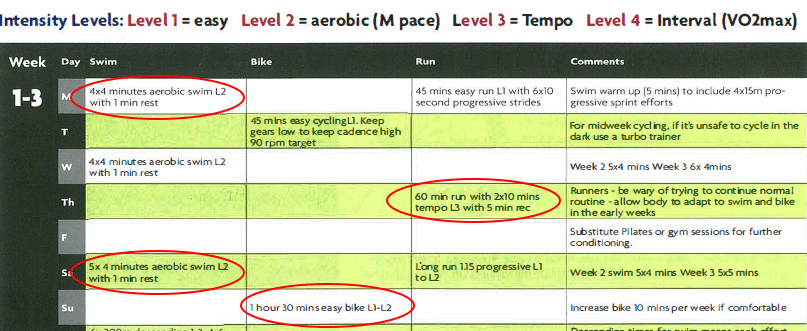
First of all, think about WHY you are going to do triathlon training:
- To get fit?
- To challenge your body to something new?
- To allocate time for yourself?
- To meet people in your community?
- To add variety to your usual training (e.g. running, cycling)?
- To fundraise for a special cause?
No matter what, have a training plan, even if you are new to triathlon.
Don’t train randomly, stick to a structured plan, otherwise you won’t see an improvement or other distractions may interfere with training.
Listen to your body, ease off if you feel tired all the time even after a rest week, if injured, or generally lacking motivation.
Finally, if all of the training seem easy and your performance is not improving, you may need to create a more challenging training plan.
Step One: Set training volume
Decide how many hours a week you can train. Be realistic, for example start with a training volume that you are currently doing even if this is only 3 training sessions a week.
Schedule a recovery week every third week or every fourth week, depending upon your recovery time, over 40s should consider a recovery week every 3rd week.
Training intensity should build up towards a performance goal or a race and a plan should be spread out over a good period of time e.g. 12 weeks. Intensity should built increased every 2 to 3 weeks; taper back for the recovery week; then build up a little more for the next 2 to 3 weeks before the next recovery week, etc. Training volume should not increase by more than 10% each week and this applies across each type of your training e.g. swim, cycle, run. Nutrition and rest (including sleep) should match the increase in training.
Step Two: Plan the number of training sessions
How many training sessions and how many in each sport?
Less frequent, longer sessions may be more suited to those who have recently trained for and completed a triathlon or who are training for a long endurance event, e.g Olympic distance or beyond.
More frequent, shorter sessions may suit those who are new to triathlon in general or for a sport which there is a weakness, e.g. a novice swimmer may not be able to manage more than a 20-30 minute training session.
How many training sessions for each sport?
Split the weekly training sessions into even amounts, e.g. if you have time for 6 training sessions each week, allow 2 training sessions for each sport. If there is not enough hours to do this, the greatest amount of sessions should be given to the weakest sport, e.g. if you only have 4 training sessions and swimming is the weakest sport the training allocation should be: 1 cycle, 1 run, 2 swims.
Step Three: Training duration
Long workouts cause physiological changes in the body which allow it to adapt to build up endurance. Short sessions allow the body to recover and can also be a full session in for those new to the sport. A training plan should consist of both types of sessions. As a broad description a short swim or run session would be under 30-40 minutes, a short bike session would be 60-90 minutes.
The longest session should be on a bike. The swim and run will make up the shorter sessions (and the weakest sport will make up the shortest of these sessions if time is a limiting factor).
Newbies sample weekly training plan (6 sessons):
| Sport | Short Session / Times a Week | Long Session / Times a Week |
| Swim | 30 mins x2 | |
| Bike | 60min turbo session | 90-120min easy cycle |
| Run | 30-40min tempo run | 60 min steady easy run |
Step 4: Deciding session intensity and variety
Pool swim or open water training?
Hill interval training or a tempo run?
Long hilly bike ride or a focus on pedalling/cadence?
Seek expert advice or discuss with fellow triathlon club members (but bear in mind their goals and fitness levels will be different to yours).
Try to get at least 3 bike/run “brick” (going straight from bike to run) sessions before a race.
Include a brick session in your standard training even if no race is coming up.
Focus on your base endurance level first before adding intensity to your training.
Once intensity training starts, a maximum of 20% of the time spent in any one sport should be high intensity sessions.
Recovery or easy sessions should be done SLOWLY, preferable using a heart rate monitor as it can sometimes be difficult to guage how slow to go.
Step 5: Print or write out your Training Plan
Spread out training sessions and rest days
Space out training sessions for different sports
Spread out the hard/long training sessions throughout the week, with rest days or short training in between
Sample Training Plan
If you don’t have 6-7 training plans as described in the graphic, pick the training sessions you can do based on the steps outlined above. For example, if you have 4 sessions available a week, and swimming is your weakest sport, pick the 4 sessions highlighted below:
Extract from 12 Week Beginners Training Plan.
Tech Tip!
There are apps available online which allow you to calculate exact mileage before a bike or run, e.g. Distances (apple store); Strava, Map my run. Build up a library of short and long courses and choose according to your training plan.

